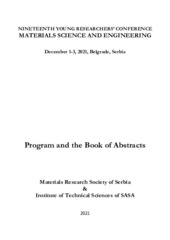Приказ основних података о документу
Development of a physiologically relevant 3D in vitro model for osteosarcoma cell cultivation comprising alginate composite scaffolds and a perfusion bioreactor system
| dc.creator | Banićević, Ivana | |
| dc.creator | Radonjić, Mia | |
| dc.creator | Pavlović, Marija | |
| dc.creator | Milivojević, Milena | |
| dc.creator | Stevanović, Milena | |
| dc.creator | Stojkovska, Jasmina | |
| dc.creator | Obradović, Bojana | |
| dc.date.accessioned | 2022-03-11T09:30:42Z | |
| dc.date.available | 2022-03-11T09:30:42Z | |
| dc.date.issued | 2021 | |
| dc.identifier.isbn | 978-86-80321-36-3 | |
| dc.identifier.uri | http://TechnoRep.tmf.bg.ac.rs/handle/123456789/5028 | |
| dc.description.abstract | Osteosarcoma is the most common type of bone cancer, which affects both children and adults. Treatment of osteosarcoma exhibits slow progress due to inadequacy of both in vivo animal models and 2D in vitro models regularly used for antitumor drug testing. Our approach is to create a physiologically relevant 3D in vitro model for osteosarcoma cell cultivation, which has the potential to overcome inherent weaknesses of 2D in vitro and animal models. In order to imitate native osteosarcoma microenvironment, macroporous alginate scaffolds with incorporated hydroxyapatite/β-tricalcium phosphate (HAp/β-TCP) powder were produced with two compositions: 1 wt% alginate, 1 wt% powder and 2 wt.% alginate, 2 wt% powder. Bioactivity and stability of the scaffolds were investigated under biomimetic conditions of continuous flow of the culture medium in perfusion bioreactor at the superficial medium velocity of 400 µm/s, which was reported in literature to be beneficial for osteogenesis. Scaffolds with the higher alginate concentration was shown to be more stable in the culture medium, since the scaffolds with the lower alginate concentration disintegrated after 5-7 days under flow conditions. Biocompatibility of the obtained scaffolds was investigated in short-term cultivation studies of murine osteosarcoma cells K7M2-wt seeded onto the scaffolds. The scaffolds were cultivated in perfusion bioreactors at the superficial flow velocity of 15 µm/s, while static cultures served as a control. After cultivation, osteosarcoma cells remained adhered to the scaffold surface, expressed metabolic activity and retained their initial proliferation ability while the flow was shown to positively affect the cultivated cells. | sr |
| dc.language.iso | en | sr |
| dc.publisher | Institute of Technical Sciences of SASA | sr |
| dc.relation | The editor and the publisher of the Book of abstracts are grateful to the Ministry of Education, Sciences and Technological Development of the Republic of Serbia for its financial support of this book and The Nineteenth Young Researchers’ Conference - Materials Sciences and Engineering, held in Belgrade, Serbia. | sr |
| dc.rights | openAccess | sr |
| dc.rights.uri | https://creativecommons.org/licenses/by-nc-nd/4.0/ | |
| dc.source | Nineteenth Young Researchers’ Conference - Materials Science and Engineering: Program and the Book of Abstracts | sr |
| dc.subject | Osteosarcoma | sr |
| dc.subject | 2D in vitro | sr |
| dc.subject | 3D in vitro | sr |
| dc.subject | scaffolds | sr |
| dc.title | Development of a physiologically relevant 3D in vitro model for osteosarcoma cell cultivation comprising alginate composite scaffolds and a perfusion bioreactor system | sr |
| dc.type | conferenceObject | sr |
| dc.rights.license | BY-NC-ND | sr |
| dc.citation.spage | 6 | |
| dc.citation.volume | 17 | |
| dc.identifier.fulltext | http://TechnoRep.tmf.bg.ac.rs/bitstream/id/7405/bitstream_7405.pdf | |
| dc.identifier.rcub | https://hdl.handle.net/21.15107/rcub_technorep_5028 | |
| dc.type.version | publishedVersion | sr |

